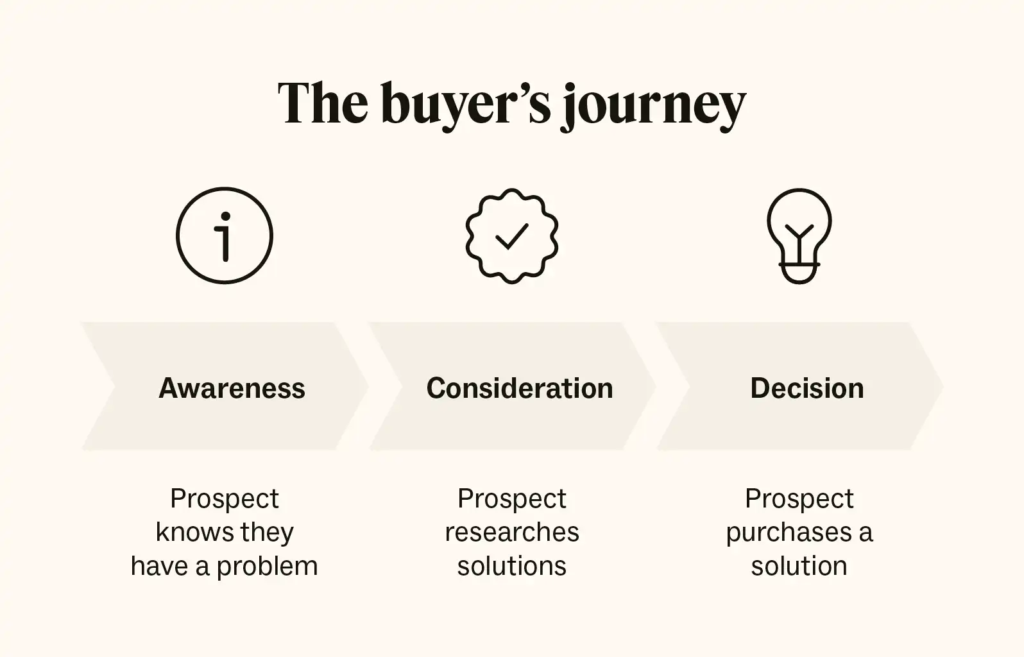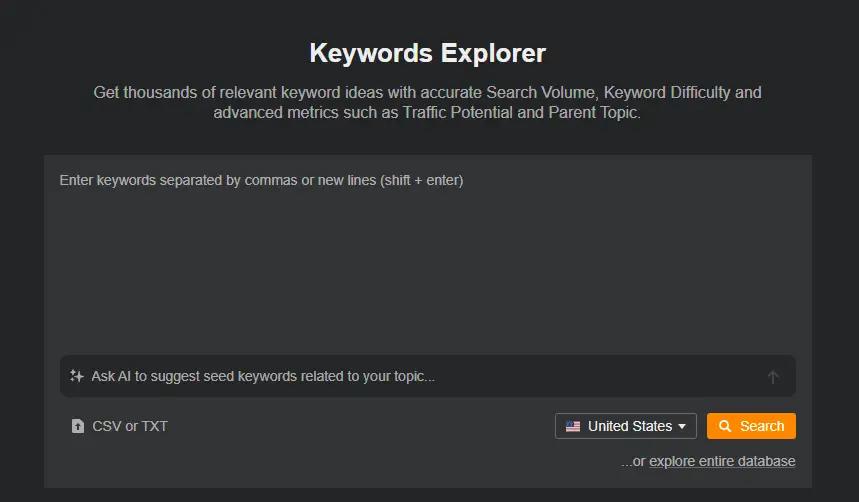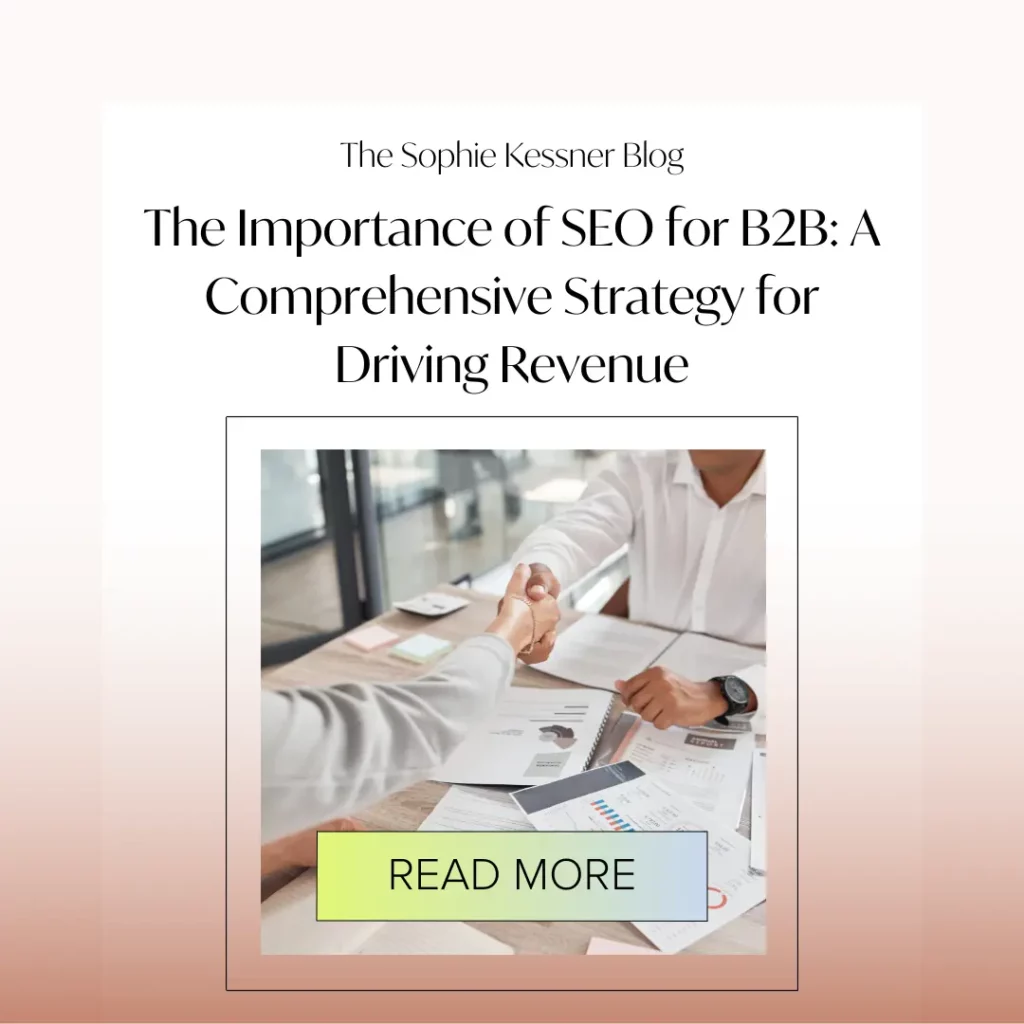These days, business buyers turn to Google and LinkedIn long before they talk to sales. Around 93% of B2B buying journeys start with an online search, which makes SEO one of the most important tools for finding and winning new clients. B2B SEO drives revenue by putting your business in front of decision-makers when they’re actively looking for solutions. It works differently from consumer-focused SEO and requires a tailored approach. With the right strategy, you can boost visibility, attract the right traffic, and fill your pipeline with qualified leads. From target keywords to content to technical setup, here’s how to make SEO work for your business—step by step.
What Exactly is B2B SEO?
B2B SEO, or search engine optimization for B2B, means tuning your website so other businesses find you when they search online. Instead of chasing casual shoppers, you’re targeting decision-makers and stakeholders who weigh long-term value and ROI, which is crucial for improving search engine rankings.
Core components
On-page SEO: Crafting clear titles, headers, and content that match business-focused keywords.
Off-page SEO: Earning backlinks from industry sites, partners, and niche directories to boost authority.
Technical SEO: Ensuring fast load times, mobile readiness, clean site structure, and error-free crawling.
Content: Publishing case studies, whitepapers, and deep-dive guides that answer specific B2B questions.
Why it’s unique
Business buyers follow a different path than consumers. They:
Look for data, reviews, and benchmarks before reaching out
Compare features, pricing, and service levels across multiple vendors
Involve several team members—marketing, finance, operations—in decisions
That means your B2B SEO must focus on clear, detailed info and smooth site experience for a variety of audiences. When you nail these basics—on-page, off-page, technical, and content—you’ll attract qualified visits and set the stage for real conversations with prospects.
Why B2B SEO is Not Just Important, It’s Essential

Businesses search online when they need solutions—and if your site isn’t there, you lose those leads before you even know they exist. B2B SEO drives revenue by making your brand visible, building trust, and feeding qualified prospects into your sales funnel. Digital marketing plays a crucial role in enhancing SEO effectiveness, helping achieve business goals like lead generation and brand awareness. Here’s how it pays off:
1. Visibility & Discoverability
Be found at the right time. When a marketing manager types “enterprise CRM comparison,” you want to rank on page one of the search engine results.
Outpace competitors. If your rivals show up first, they grab the lead, even if your product is a better fit.
2. Driving Qualified Traffic
High intent visits. People searching specific business terms are close to a decision.
Lower bounce rates. When valuable content aligns with search intent—like a whitepaper on ROI calculations—visitors stick around.
Tip: Review your top 10 landing pages—are they optimized for real B2B queries? If not, update titles and headers this week.
3. Cost-Effectiveness vs. Other Channels
Long-term payoff. A well-ranked page keeps drawing leads for months, unlike paid ads that stop when you pause the budget.
Budget-friendly. You don’t always need heavy ad spend; an effective SEO strategy and expert SEO work can reduce cost per lead.
4. Authority and Trust
Thought leadership. Publishing detailed guides or case studies shows you know your stuff.
Credible backlinks. When industry sites link to you, Google treats your domain as a trusted source. Additionally, attracting relevant traffic through these backlinks is crucial for achieving long-term business goals and fostering valuable client relationships.
5. Sales Process Support
Lead nurturing. SEO content can answer common objections before a prospect even emails your team.
Shorter sales cycles. Educated buyers move faster because they’ve already done their homework.
Example: We helped a SaaS client improve organic rankings for “API integration best practices.” Within three months, organic demos rose by 65%.
6. Direct Impact on Revenue
Trackable results. Use Google Analytics to see how many leads come from organic search, then link that to closed deals. Key performance indicators (KPIs) such as conversion rates and lead quality can help you evaluate the effectiveness of your SEO efforts.
Scalable growth. As you add more optimized pages, you expand your reach across new business segments.
It’s no surprise that 57% of B2B marketers say SEO generates more leads than any other marketing tactic. By focusing on B2B SEO, you turn your website into a lead engine that works 24/7. The effort you invest in keywords, content, and links directly feeds sales conversations—and that’s how SEO becomes a growth driver, not just a marketing checkbox.
The Fundamental Differences: B2B SEO vs. B2C SEO

Businesses and consumers search with different goals and mindsets. Tailoring your SEO approach to those differences helps you reach the right people at the right time by creating SEO-optimized content.
Audience
B2B: You’re talking to teams—marketing directors, IT managers, procurement officers—who look for data, case studies, and ROI.
B2C: You’re reaching individuals motivated by personal needs, trends, or emotions.
Takeaway: In B2B, your content must answer complex questions and back claims with facts. Effective B2B SEO strategies involve not just keyword optimization but also content marketing and technical SEO practices that collectively contribute to improved search rankings and generate qualified leads. In B2C, you can tap into feelings, quick wins, and impulse triggers.
Sales Cycle
B2B: Long and winding. Prospects research, compare options, loop in stakeholders, and plan budgets.
B2C: Short and simple. Shoppers look, click “buy,” and move on.
Takeaway: B2B SEO needs multiple content pieces at each stage—awareness, consideration, decision—while B2C can focus on clear product pages and fast checkouts. Leveraging SEO best practices is crucial for B2B strategies to improve discoverability, lead generation, and drive qualified traffic by aligning with the search behaviors of decision-makers.
Keywords & Search Intent
B2B: Lower search volume but high intent. Examples: “enterprise cybersecurity ROI,” “best CRM for small finance teams.”
B2C: Higher search volume and broader. Examples: “best sneakers 2025,” “summer dress sale.”
Takeaway: B2B keyword research should prioritize buyer-stage terms—“compare,” “pricing,” “case study”—and filter by CPC or estimated deal value. A well-developed keyword strategy should align with business objectives and utilize topic clusters to organize content around specific themes, targeting prospects at different stages of the buying funnel.
Content Strategy
B2B: Educational and detailed. Think whitepapers, how-to guides, industry reports, and deep-dive blog posts.
B2C: Engaging and quick. Think listicles, reviews, videos, and social posts.
Takeaway: B2B content must show expertise and ROI. For example, an “API integration checklist” helps an engineer and a CTO see value. B2C content can lean on eye-catching headlines and visual appeal to drive clicks.
Decision-Making Process
B2B: Rational and multi-layered. Buyers need proof, demos, trials, references—and a clear path to long-term value.
B2C: Emotional and fast. Shoppers react to price, trends, and peer reviews.
Takeaway: Align B2B SEO to nurture each stakeholder—create separate landing pages for technical specs (for engineers) and ROI summaries (for executives). In B2C, one optimized product page often suffices.
While B2C may lean on quick-turn PPC campaigns, over 80% of businesses say SEO brings in higher quality leads—ideal for long sales cycles and detailed decision-making. Effective SEO strategies are crucial for business growth, as they enhance online visibility, attract quality leads, and drive revenue.
Navigating the Complex B2B Buyer’s Journey with SEO

In B2B, buyers move through several stages before they pick a vendor. SEO can guide them at each step, turning your site into a helpful resource that nudges prospects closer to a purchase.
1. Map the Funnel Stages
Awareness: Prospects spot a problem (“how to improve supply chain visibility”) by conducting keyword research to understand what their target audience is searching for.
Consideration: They compare solutions (“top supply chain management tools”).
Decision: They evaluate vendors (“XYZ Software pricing and reviews”).
2. Align Content & SEO Tactics
Awareness stage
Content types: Blog posts, infographics, industry reports
SEO focus: ToF topics and high-volume keywords that introduce pain points and aim to rank prominently on search engine results pages (SERPs) to enhance visibility and attract more website traffic.
Consideration stage
Content types: Comparison guides, case studies, webinars
SEO focus: Mid-funnel keywords like “vs,” “best,” “features,” and optimizing individual web pages to enhance their relevancy and visibility in search engine results.
Decision stage
Content types: Product pages, pricing sheets, demos
SEO focus: BoF terms such as “buy,” “pricing,” “trial”
Tip: Use a simple spreadsheet to map your existing pages to each funnel stage. Spot gaps and plan new content where you’re missing coverage. Optimizing these elements can significantly improve your keyword rankings, enhancing your website’s visibility and traffic.
3. Leverage the Longer Journey
More keyword opportunities: Each stage has its own search terms—target dozens of phrases rather than a handful.
Multiple entry points: A prospect might start with a blog post, then land on a case study, and end at a pricing page. Strong internal linking keeps them moving.
Deeper engagement: You can offer gated assets (whitepapers, toolkits) to capture leads and email nurture them through the funnel.
When you tailor SEO to the buyer’s path, your site doesn’t just rank—it guides decision-makers step by step. That builds trust, speeds up buys, and turns organic search into a sustained lead machine. Monitoring and analyzing seo performance at each stage ensures your strategy remains effective and aligned with your goals.
Building Your Foundation: Essential Pre-Strategy Steps

Before you dive into tactics, lock down these three essentials. They set you up to target the right terms, craft relevant content, and avoid wasted effort.
A well-defined digital marketing strategy is crucial in B2B marketing, as it integrates SEO to drive lead generation, brand awareness, and customer education.
1. Create Detailed B2B Buyer Personas
Who they are: List titles (e.g., IT director, procurement lead), company size, and industry.
Pain points & goals: What problems keep them up at night? What metrics matter—cost savings, uptime, scalability?
Content needs: Do they prefer data-driven whitepapers, quick blog posts, or demo videos?
Tools: Use surveys (Typeform), interviews, and LinkedIn polls to gather real insights. Additionally, consider the domain authority of sources when gathering data to ensure the strength and credibility of your content.
2. Understand Your Unique Sales Funnel
Talk to sales teams: Ask where prospects stall or drop off.
Analyze data: Check Google Analytics and your CRM for common entry and exit pages.
Identify touchpoints: Pinpoint content or pages that drive demo requests, downloads, and trials.
Action: Sketch a simple flowchart—show how someone moves from awareness content to your contact form. Integrate this with your broader marketing efforts to enhance visibility and lead generation.
3. Conduct a Comprehensive Technical SEO Audit
Site structure: Ensure logical URLs, clear navigation, and proper use of headings.
Performance checks: Test page speed (Google PageSpeed Insights) and mobile-friendliness.
Crawl & index review: Use Screaming Frog or Sitebulb to find broken links, duplicate pages, and crawl errors.
Security & UX: Confirm you have HTTPS and no intrusive pop-ups that frustrate business users.
Adapt to AI-driven changes: With Google’s Search Generative Experience reshaping how information is accessed, ensure your content is original, in-depth, and utilizes schema markup to enhance visibility in AI-generated answer summaries.
Tip: Schedule quarterly audits. Small fixes—like compressing images or fixing a 404—add up to better rankings and happier prospects.
With personas, funnel insight, and a clean technical base, you’ll maximize every SEO move and lay the groundwork for the deep-dive tactics ahead.
Mastering B2B Keyword Research

Before you write a single post or optimize a page, nail down the terms your buyers actually use. In B2B, that means mixing low-volume, high-intent phrases with broader topic ideas.
By aligning content with detailed buyer personas throughout the buying process, you can foster meaningful engagement that enhances relevance and effectiveness in search experiences.
Finding Bottom-of-Funnel (BoF) Keywords
High intent > high volume. Look for terms like “enterprise ERP pricing” rather than “ERP.”
Methods:
Seed keywords: Start with a handful of obvious terms.
Google Autocomplete & “People also ask”: See how buyers phrase questions.
Competitor analysis: Use tools (Semrush, Keyword Planner, Moz Explorer) to pull your rivals’ top-ranking terms.
Filter for value: Sort by CPC or estimated deal size, not just search volume. Utilize SEO tools to uncover hidden opportunities, enhance data analysis, and track industry-specific and relevant keywords for a more effective SEO approach.
Identifying Top-of-Funnel (ToF) Topics/Keywords
Problem-aware searches: Phrases like “how to track inventory errors” cast a wider net.
Volume and reach: These keywords draw more visits and feed your email list or gated assets.
Tool tips: Exploding Topics and Topic Research can surface rising themes in your industry, especially as decision-makers increasingly use mobile devices to research and make purchasing decisions.
Balancing Long-Tail vs. Short-Tail
Long-tail: “SaaS API integration checklist” — lower competition, clear intent, easy wins.
Short-tail: “API integration” — broader, tougher to rank, but vital for brand awareness.
Strategy: Aim for a mix—50% long-tail, 50% short-tail—to reach potential customers at every stage. A solid SEO strategy that supports your business goals helps bring in the right traffic, keep people engaged, and use tools like AI to improve your content and results.
Competitor Keyword & Content Gap Analysis
Pull competitor URLs into your keyword tool.
Export their ranking terms and compare against your list.
Spot gaps: Topics they cover that you don’t—especially if those terms show commercial intent.
Plan content: Build missing pages or expand existing posts to fill those gaps, ensuring you enhance search visibility by focusing on user experience, content quality, and strategic integration with other digital marketing channels.
Tip: Keep a live spreadsheet of BoF and ToF keywords. Update it monthly to catch new opportunities and drop dead keywords.
With targeted BoF phrases feeding your product/service pages and ToF topics driving awareness content, your keyword map becomes a roadmap for growth.
On-Page Optimization for B2B Success

On-page SEO ties your keyword research to real pages. When you place terms where they matter, search engines and buyers both know you’ve got the answers they need.
Establishing yourself as an industry leader within the B2B space is crucial for enhancing your market position and driving traffic through effective SEO strategies.
1. Optimize Product & Service Pages
Target BoF keywords: Use your Bottom-of-Funnel terms in page titles, headers (H1/H2), and meta descriptions.
Clear value props: Open with a one- or two-sentence summary that states what you do and who you help.
Call to action: Place a clear “Request a demo” or “Download specs” button above the fold to improve website traffic.
2. Commit to 100% Unique Content
No thin pages: Each page should offer fresh insights—compare, contrast, or expand on competitors.
Avoid copy-paste: Rewrite supplier or partner info in your own words, adding your unique case studies or data.
3. Leverage Long-Form Content
Why it works: Pages over 1,000 words tend to rank higher and answer more related queries.
Structure for skimming: Use subheadings, bullet points, and short paragraphs so busy execs can grab key points.
4. Strategic Keyword Usage
Titles & URLs: Keep them concise (50–60 characters for titles), include primary keywords up front. Optimize title tags to reflect the page’s specific focus and include primary keywords for better visibility, as they significantly influence click-through rates (CTR).
Headers & body: Spread related terms (LSIs) naturally—“organic lead generation,” “content for business buyers,” and “technical SEO audit.”
Meta descriptions: Write 150–160 character summaries that tease the page’s benefit and include one key phrase.
5. Improve UX Signals
Fast load times: Compress images, enable lazy loading, and stick to clean code.
Mobile readiness: Many decision-makers browse on tablets or phones—test on various devices.
Intent alignment: Match page content to searcher needs. If someone clicks “procurement software features,” don’t land them on a pricing page. A successful SEO strategy involves aligning your content with user search intent, which is crucial for improving UX signals and increasing visibility.
Tip: Run a simple Google search for your target keyword. Click the top three results—note what they cover and how they structure content. Use that as a template to beat them.
Crafting a High-Value B2B Content Strategy

A strong content plan keeps your audience hooked and moving through the funnel. For B2B, that means offering resources that solve real problems and build trust over time. Successful B2B marketing strategies must engage multiple decision makers, addressing the unique concerns of each stakeholder involved in the purchasing process.
1. Focus on “Shoulder” Topics
Beyond direct sales: Cover related areas—like “data security best practices” if you sell cloud backup.
Broader reach: These topics attract top-of-funnel readers who may not be ready to buy but will sign up for newsletters or downloads.
2. Map Content to the Buyer’s Journey
Awareness: Publish blog posts or infographics that explain a pain point (“Why manual reporting fails finance teams”).
Consideration: Offer comparison guides or webinars (“Cloud vs. on-prem reporting: Pros and cons”).
Decision: Create case studies, ROI calculators, or in-depth demos that help close deals and generate valuable backlinks.
Tip: At the start of each piece, add a sentence like “In this post, you’ll learn…” so busy readers know exactly what to expect.
3. Diversify Content Formats
Blogs: Quick reads that answer specific questions.
Ultimate Guides: Deep dives that become cornerstone content and attract backlinks.
Whitepapers & e-books: Gated assets that generate leads.
Case Studies & Testimonials: Social proof for decision-makers.
Webinars & Videos: Live demos or panel discussions that showcase expertise.
Podcasts & Tools: Audio interviews or calculators that keep your brand top of mind.
Creating Content: Developing tailored content that addresses the specific concerns of various decision-makers and aligns with their search intent, thereby enhancing visibility and engagement.
4. Establish Thought Leadership
Share original data or insights: Survey clients and publish results that are tailored to your target audience. Understanding your target audience’s preferences and needs can help you create more relevant and engaging content.
Guest posts & interviews: Appear on industry sites or podcasts to expand your reach.
5. Adopt a “Business Casual” Tone
Keep it friendly: Write like a colleague sharing tips, not a formal report.
Add mini anecdotes: “When we tested this tip, our email signups jumped 30% in one month.”
Use clear examples: Show exact tools or steps—no vague statements. Make your content a valuable resource by addressing various stakeholder needs and effectively fulfilling their information requirements. This will reinforce your brand’s position as a trusted advisor.
6. Audit and Optimize Regularly
Content audits: Every six months, review top pages for accuracy and freshness.
Update stats and links: Make sure case studies and data points stay current.
Repurpose high-performers: Turn a popular blog into a webinar or infographic.
With a diversified, journey-aligned content plan, you’ll drive organic lead generation and cement your role as an expert resource.
Building a Scalable B2B Link Building Strategy
Earning quality backlinks shows Google your site is a trusted resource. In B2B, links from industry sites, partners, and tools pages carry extra weight. Here’s how to build a link profile that scales.
While paid search requires ongoing investment, organic search traffic yields lasting benefits from initial marketing efforts, illustrating the long-term value of SEO in generating qualified leads at a lower cost.
1. Focus on Industry-Specific Digital PR
Target niche outlets: Pitch stories or data to B2B blogs, trade publications, and industry forums.
Data-driven angles: Share survey results or benchmarks—sites love original stats.
Local and sector events: Sponsor or recap webinars and conferences to earn mentions.
Enhance search engine understanding: Focus on optimizing user experiences and utilizing structured data to help search engines accurately interpret your content. This includes mobile optimization, voice search, and ensuring accessibility to improve visibility.
2. Create Helpful Tools and Calculators
Interactive assets: An ROI calculator or cost-savings estimator draws organic links from blogs and social shares.
Easy embed code: Offer a simple snippet so partners can add your tool to their sites (and link back).
Optimize title tag: Ensure the title tag of your tool’s page includes the primary keyword near the beginning and is within the recommended character limits. This helps improve click-through rates and makes your tool more competitive on search engine results pages.
3. Partner and Resource Page Outreach
Vendor directories: Ask partners to list you on their “trusted suppliers” pages to gain high quality backlinks.
Resource lists: Find pages that link to generic resources (“top CRM tools”) and suggest adding yours to acquire high quality backlinks.
4. Guest Blogging with Purpose
Select high-authority sites: Aim for industry blogs that reach your decision-makers.
Include one link to a relevant guide: A link to your ultimate guide on “search engine optimization for B2B” provides value—avoid blatant sales pitches. Understanding user behaviors and how they evolve can make your content more relevant and engaging.
5. Broken Link Building
Find dead links on relevant pages (use a tool like Screaming Frog).
Offer your content as a replacement—send a friendly note pointing out the broken link.
Follow up briefly if you don’t hear back in a week. Ensure that this approach aligns with your overall marketing strategy to maximize the benefits of broken link building.
6. Quality Over Quantity
Vet domains: Aim for sites with real traffic, clear industry focus, and a good domain rating.
Avoid spammy networks: One link from a top trade site beats dozens from low-value sources.
Tip: Keep a shared spreadsheet of outreach targets, status updates, and outcomes. Aim for 5–10 new quality links each month to build momentum.
With these tactics, you’ll earn relevant links that boost authority, improve rankings, and ensure your site appears in relevant search results, funneling more organic lead generation to your site.
Strengthening Your Technical SEO Foundation
Technical health keeps your site fast, crawlable, and ready to convert business buyers. Neglect these basics, and even great content won’t rank. Utilizing analytics tools can help you analyze large data sets to identify trends and optimize your SEO strategies. Here’s what to tackle:
1. Speed & Core Web Vitals
Measure performance: Run Google PageSpeed Insights or Lighthouse on key pages.
Fix slow elements: Compress images, minify CSS/JS, and use browser caching.
Optimize loading: Enable lazy loading for below-the-fold images and defer non-essential scripts. Effective content marketing also plays a role in improving site speed by ensuring that high-quality, relevant content is efficiently delivered to users, enhancing their overall experience.
2. Mobile-Friendliness
Responsive design: Check that menus, buttons, and forms work on phones and tablets.
Mobile tests: Use Google’s Mobile-Friendly Test to spot issues with touch targets or text size.
Prioritize key pages: Make your product, demo, and contact pages load flawlessly on small screens. Analyzing user behavior on these pages can provide insights into how users interact with your content, helping you optimize for better engagement and performance.
3. Site Architecture & Internal Linking
Clear structure: Arrange pages in logical folders (e.g., /solutions/erp/ instead of /12345/).
Flat hierarchy: Keep important pages no more than three clicks from the homepage.
Link flow: In every blog post or guide, link to relevant service pages and cornerstone content to spread authority and improve search rankings.
4. Schema Markup
Select relevant types: Add Organization, FAQ, and Breadcrumb schema to help Google understand your content.
Verify in Search Console: Check for errors in your structured data reports.
Test with Rich Results Tool: Confirm that markup renders correctly before you publish.
Produce high quality content: Ensure your content is of high quality to enhance brand authority and credibility, engage your target audience effectively, and address their needs throughout various stages of the sales funnel.
5. Handling Website Migrations
301 redirects: Map old URLs to new ones to preserve rankings.
Update internal links: Scan for broken links after launch and fix them in your CMS.
Monitor performance: Track organic traffic and errors in Google Search Console for at least a month. Integrate these efforts into your broader marketing strategies to ensure a seamless transition and maintain your site’s visibility and credibility.
6. Regular Technical Audits
Schedule quarterly checks: Use Screaming Frog, Sitebulb, or Ahrefs Site Audit to catch new errors.
Prioritize fixes: Address high-impact issues—crawl errors, duplicate content, and redirect chains—first.
Track improvements: Record load times and crawl stats to show how your technical work moves the needle.
Tip: Create a “tech SEO dashboard” in your analytics tool. Track Core Web Vitals, mobile usability, and crawl errors side by side so you spot trends and tackle problems before they hurt rankings.
By keeping your technical SEO in top shape, you ensure every piece of content ranks smoothly, loads fast, and delivers a seamless experience to decision-makers.
Leveraging Social Media (Indirectly) for B2B SEO
Social channels aren’t direct ranking signals, but they boost your SEO by getting content in front of more eyes—and earning shares, visits, and links.
Content distribution:
Post blog snippets, infographics, or case-study highlights on LinkedIn and Twitter.
Use industry groups and hashtags (e.g., #B2BMarketing, #TechLeaders) to reach decision-makers.
Engagement & brand awareness:
Host live Q&As or panel discussions on LinkedIn Live or Twitter Spaces.
Encourage employees to share company posts—each share expands your reach.
Backlink opportunities:
When your content gains traction, industry bloggers and journalists notice and link back.
Monitor brand mentions (with tools like Mention) and request links where appropriate.
Tip: Schedule social posts to coincide with new content drops. That first wave of traffic can signal relevance to search engines and kickstart link-building.
Essential Tools for Your B2B SEO Toolkit
Having the right tools speeds up research, tracking, and fixes. Here’s your go-to list for every stage of B2B SEO:
1. Keyword Research & Content Planning
Semrush / Ahrefs / Moz: Find BoF and ToF terms, check competitor rankings, and spot content gaps.
Google Keyword Planner: Free insights on search volume and CPC for “SEO strategy for businesses.”
Exploding Topics / Topic Research (Semrush): Discover rising industry themes before they go mainstream.
2. Technical & On-Page Audits
Screaming Frog / Sitebulb: Crawl your site to spot broken links, duplicate pages, and missing metadata.
Google PageSpeed Insights / Lighthouse: Test speed, Core Web Vitals, and mobile readiness.
Schema Markup Generator: Create and validate your Organization, FAQ, and Breadcrumb schema.
3. Link Building & PR
BuzzSumo: Find popular industry content and influencer contacts for outreach.
Hunter.io: Gather verified email addresses for partner or guest-post pitches.
Ahrefs Link Explorer / Majestic: Check domain ratings and see where your competitors earn links.
4. Analytics & Reporting
Google Analytics / Search Console: Track organic traffic, conversions, and index coverage.
Dreamdata / HubSpot: Tie SEO leads back to closed deals for clear SEO ROI measurement.
Data Studio / Looker: Build a custom dashboard for KPIs like “organic lead generation” and “measuring SEO ROI.”
Tip: Start with free or trial versions to find your favorites. Then upgrade tools that save you the most time and deliver the best insights.
Monitoring, Analysis, and Measuring B2B SEO Success
Tracking your progress shows what’s working and where to adjust. Focus on metrics that tie SEO efforts to real business results.
1. Set Clear KPIs
Organic traffic: Year-over-year and month-over-month trends for key pages.
Leads generated: Form fills, demo requests, downloads tied to SEO content.
Conversion rate: Percentage of visitors who become leads.
SEO ROI: (Value of closed deals from organic leads) ÷ (SEO spend).
2. Use the Right Tools
Google Analytics & Search Console: Monitor sessions, queries, and index issues.
CRM integration: Connect tools like HubSpot or Salesforce to tag SEO-sourced contacts.
Attribution modeling: Apply first-click or time-decay models to credit content properly.
3. Build a Simple Dashboard
Visualize trends: Plot organic visits, leads, and conversions over time.
Highlight wins: Note pages with big jumps or drops.
Share monthly reports: Keep stakeholders in the loop and show progress toward revenue goals.
4. Regular Reviews & Adjustments
Content performance: Update or prune posts with low engagement.
Keyword shifts: Add new terms when search behavior changes.
Technical checks: Watch for crawl errors or slow pages that hurt rankings.
By measuring the right metrics and reviewing them often, you’ll keep your B2B SEO strategy aligned with growth goals and adapt quickly to changes.
The Growing Role of AI in B2B SEO
AI tools aren’t just buzz—they’re reshaping how we research keywords, create content, and spot trends in B2B SEO.
1. AI-Powered Keyword Research
Intent analysis: AI helps group keywords by buyer stage and intent, so you target decision-makers with “technical SEO audit checklist” or “enterprise CRM pricing.”
Trend spotting: Tools like MarketMuse or Clearscope use AI to surface rising topics before rivals catch on.
2. Content Creation & Optimization
Drafting help: AI assistants can outline blog posts or suggest headings that match search intent. You still add the expertise—AI is your writing partner, not a replacement.
On-page tweaks: Platforms like Surfer SEO use AI to recommend keywords, headings, and word counts based on top-ranking pages.
3. Data Analysis & Insights
Automated reports: AI dashboards can flag drops in organic and paid search traffic or spikes in bounce rate faster than manual checks.
Predictive modeling: Some tools forecast keyword difficulty or traffic gains, helping you prioritize high-ROI topics.
4. Personalized Experiences
Dynamic content: AI can show different case studies or CTAs based on visitor role (e.g., CTO vs. procurement lead).
Chatbots & virtual assistants: Leverage AI chat to answer quick pre-sale questions and capture leads.
Tip: Test one AI tool at a time. Measure its impact on your workflow and results before adding more. AI can speed up B2B SEO tasks, but human oversight keeps your brand voice and accuracy on point.
Common Challenges in B2B SEO and How to Overcome Them
Even with a solid plan, B2B SEO has its bumps. Here are four common hurdles and quick fixes:
1. Low Search Volume Keywords
Challenge: High-intent terms often have few monthly searches.
Fix: Bundle related low-volume phrases into cluster pages or guides to boost overall traffic.
2. Complex Sales Cycles
Challenge: Multiple stakeholders slow decisions and dilute content impact.
Fix: Create tailored landing pages for each role (e.g., CTO, procurement) that answer their specific concerns.
3. Proving ROI
Challenge: Linking SEO work directly to revenue can feel murky.
Fix: Use CRM tracking and UTM parameters to tag organic links, then compare leads and closed deals month over month.
4. Resource Constraints
Challenge: Tight budgets and small teams limit content and outreach.
Fix: Prioritize high-impact tasks—BoF keyword pages and key technical fixes—before broader campaigns.
By spotting these issues early and focusing on smart solutions, you’ll keep your SEO engine humming and your growth goals on track.
Investing in B2B SEO for Long-Term Growth
Your website can do more than sit idle—it can work around the clock to bring in qualified leads and support every step of the buying journey. By mastering B2B SEO—from focused keyword research and solid on-page setup to technical health, link building, and the smart use of AI—you’ll reach decision-makers, build trust, and power steady revenue growth. The digital landscape will keep shifting, so stay curious, track your results, and tweak your approach.
Want help getting started? At Sass and SEO, we make it easier with our DIY SEO Course—perfect for B2B brands ready to take control without the fluff. Check it out and start building SEO that drives real results.
Frequently Asked Questions (FAQs)
1. Why is SEO important for B2B companies?
SEO helps B2B companies get found by decision-makers who are actively searching for solutions. It brings in qualified leads, supports the sales process, and builds trust through helpful, search-optimized content.
2. How is B2B SEO different from B2C SEO?
B2B SEO targets professionals and teams, not individual consumers. The content is usually more educational and ROI-focused, and the sales cycle is longer with multiple touchpoints.
3. What types of content work best for B2B SEO?
Long-form guides, case studies, whitepapers, and comparison pages work well. They help answer detailed questions and build authority during the research and consideration stages.
4. How long does it take to see results from B2B SEO?
It usually takes 3–6 months to see measurable traffic and lead improvements. SEO is a long game, but it builds lasting momentum and lower customer acquisition costs over time.
5. Can small B2B businesses do SEO without hiring an agency?
Yes! With the right tools and guidance, small businesses can run effective SEO in-house. Our DIY SEO Course at Sass and SEO is designed to help you do exactly that—step by step.





